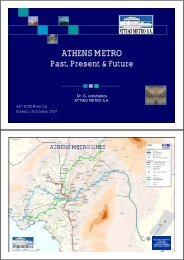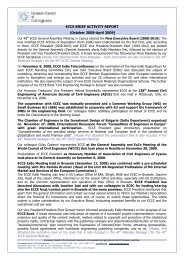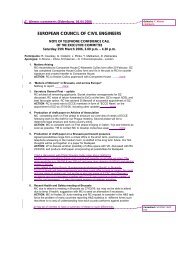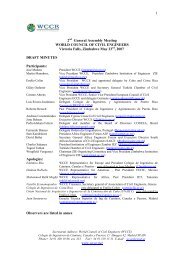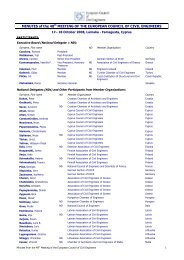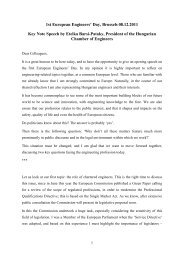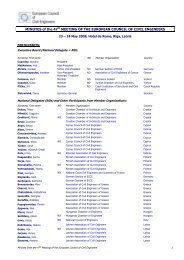A Closer Look at Prevailing Civil Engineering Practice - European ...
A Closer Look at Prevailing Civil Engineering Practice - European ...
A Closer Look at Prevailing Civil Engineering Practice - European ...
Create successful ePaper yourself
Turn your PDF publications into a flip-book with our unique Google optimized e-Paper software.
A <strong>Closer</strong> <strong>Look</strong> <strong>at</strong> <strong>Prevailing</strong> <strong>Civil</strong> <strong>Engineering</strong> <strong>Practice</strong>, Wh<strong>at</strong>, Why and How<br />
Vincent T. H. CHU<br />
14. Wh<strong>at</strong> is the significance of null point in bridge deck<br />
The null point is the position of zero movement in the bridge deck. When<br />
the bridge deck is pinned <strong>at</strong> a single pier, it provides the loc<strong>at</strong>ion of null<br />
point with no deck movement. However, when the bridge deck is pinned to<br />
more piers, the position of null point has to be calcul<strong>at</strong>ed. The<br />
determin<strong>at</strong>ion of null point is important because it serves to estim<strong>at</strong>e the<br />
forces on the piers by deck length changes and to calcul<strong>at</strong>e the sliding<br />
movement of sliding and free bearings.<br />
For symmetrical deck founded on two identical fixed piers, the null point<br />
should be midway between the two fixed piers. However, if one pier is taller<br />
than the other, the null point would be shifted to the shorter stiffer pier.<br />
15. In span-by-span construction, which prestress layout is better (i)<br />
single-span coupled cable or (ii) two-span overlapped cable<br />
For single-span coupled cable, the length of cable is one span and they are<br />
coupled <strong>at</strong> the construction joint which is loc<strong>at</strong>ed <strong>at</strong> 0.25 of span. The use<br />
of single-span coupled cable in span-by-span construction suffers the<br />
following drawbacks:<br />
(i) Stressing all tendons in one span is time consuming. Moreover, the<br />
construction team has to wait until the concrete has gained enough<br />
strength before all tendons in the span to be stressed.<br />
(ii) Extra time is required for coupling of tendons.<br />
(iii) The accommod<strong>at</strong>ion of coupler requires the lowering of designed<br />
tendon profile. Moreover, the coupler occupies large space in bridge<br />
web which is the region of high shear forces. To avoid gener<strong>at</strong>ing a<br />
weak point in web, the web has to be locally thickened to maintain<br />
sufficient thickness of concrete.<br />
(iv) Couplers have a higher risk of failure when compared with normal<br />
anchorages. The success of such prestress layout is highly<br />
dependent on the quality of coupler and workmanship because<br />
coupling of all prestressing tendons is carried out <strong>at</strong> the same point.<br />
(v) The tendon length is only one span long which is economically<br />
undesirable.<br />
For two-span overlapped cable, the cable is two-span long. At each<br />
construction phase in span-by-span construction, only 50% of tendons are<br />
stressed. In most cases, 50% tendons stressing would be sufficient to carry<br />
its self weight upon removal of falsework. As such, it allows the use of more<br />
11






